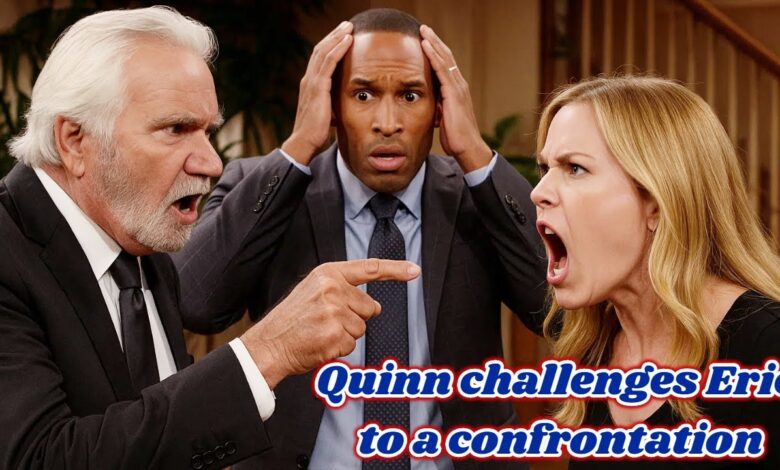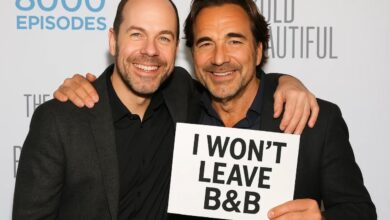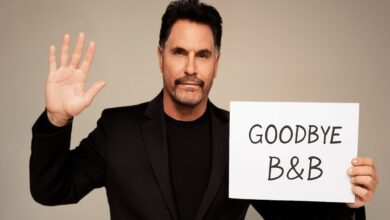Quinn returns with a new face looking to confront Forester The Bold and the Beautiful Spoilers

The Bold and the Beautiful: Quinn’s Unapologetic Return Shakes Los Angeles and Redefines the Jewelry Wars
When Quinn returns to Los Angeles, it’s without apology and without the familiar face the audience remembers. A new actress carries the name now—wielding it like both a blade and a promise. She steps back into the world not as a woman seeking redemption, but as a force of calculated disruption, armed with a jewelry brand that refuses to compete on sparkle alone. Instead, it competes on something far more intimate—the human heart.
Quinn doesn’t come back empty-handed. She arrives tethered to a rival European fashion powerhouse, Maison Rell—a name as steeped in old money as it is in ruthless precision. This isn’t the romanticized glamour of the runway; it’s the cold, surgical ambition of the boardroom. The so-called “collaboration” between Quinn’s line and Rell behaves less like a joint venture and more like a takeover in slow motion.
Their pitch is devastating in its simplicity: Exclusive Emotion. Each piece of jewelry contains a microchip embedded in precious metals and stones, designed to capture the wearer’s most intimate moments—peaks of joy, shared laughter, the perfect kiss, a child’s recital, a hard-won boardroom victory—and translate those biometric signatures into bespoke designs. These patterns are etched into gold and platinum, creating not just ornaments, but wearable monuments to memory.
The launch campaign is intoxicating—shot on a rainwashed Paris street, Quinn’s voice purrs through the commercial: “You’re not buying a diamond. You’re buying proof you felt something unrepeatable.”
Forester Sees the Threat Before the First Move Is Made
When the campaign video hits Forrester Creations’ screens, the room goes silent. Eric Forrester is the first to recognize the scale of the strike. This isn’t a battle over fabric or exclusivity clauses—it’s a raid on the human psyche. If Maison Rell convinces clients that meaning itself can be minted, that memories can be authenticated like currency, then couture risks becoming mere decoration, stripped of its emotional crown.
Brooke’s instinct is to check the legalities before her pulse. Ridge bristles in pure defense. Hope, ever the romantic, wonders aloud how you keep love safe once technology lives under your skin. Carter—whose past with Quinn is a chapter he’s spent years locking away—hears “exclusive emotion” and stops breathing for a beat.
Maison Rell’s Seduction Strategy
At her Paris debut, Quinn stages the perfect theater of seduction. In a converted chapel off Rue St. Donor, two co-founders dressed in ink-black suits demonstrate the technology onstage with a couple flown in from Dubai. A thin ring sits dormant until the pair decides to capture a moment. They press their thumbs, a soft chime sounds, and the chip records a spike in their shared signals. Hours later, a bracelet is unveiled—its filigree echoing the couple’s “joy curve” and micro-engravings threading their synchronized heartbeats into an intimate code.
The audience is spellbound. Forrester’s buyers start texting from the event in a panic: How fast can we respond?
Carter Finds the Fine Print
Carter digs into the legal underbelly. Consent screens. Data retention clauses with “short” windows that hide dangerous exceptions. A loophole that lets Rell store anonymized derivatives forever—raising the question: how anonymous can a pattern of your life really be? He brings it to Eric, who understands the stakes immediately.
If they claim the body, we claim the soul, Eric declares.
The Counterattack: “No Chip. All Heart.”
Forrester’s counterprogramming is a masterstroke: No Chip. All Heart. A salon-style event where clients bring heirlooms to be recut and redesigned live, guided not by algorithms but by human stories. Every stone comes with a handwritten provenance card in the client’s own words. No data recorded. No servers. Just trust.
Quinn Plays the Long Game
Quinn’s recast is written into the show itself, not hidden. She tells Carter: “Time changed me. Let it change how you see me—or don’t. But don’t pretend the world stood still while you moved on.” It’s a surgical strike of dialogue—one that earns the new Quinn credibility with both the in-show world and the real audience watching at home.
The Marriage That Isn’t
Quinn offers Forrester a deal: a limited run of emotion-exclusive pieces sold through Forrester boutiques, with full autonomy on design. The upside is enormous; the risk is existential. Accepting validates the tech. Refusing risks losing clients to Paris. Eric negotiates an audacious compromise: sell to only five legacy clients, each offered two versions—one built from data, one from dialogue—and let them choose. The results will be published publicly.
Carter’s Line in the Sand
Quinn tries to name Carter as the ethics liaison with veto power over the tech—a role that would keep him in her orbit. Eric gives him a silent nod: Do what keeps you whole. Carter refuses, unwilling to be the face that makes her machine look gentle.
Dueling Events, Dueling Philosophies
Forrester’s No Chip. All Heart. event glows with warmth and human craft. Across town, Quinn stages a counter—a private session where the algorithm builds a pattern from archival audio. The curve eerily resembles a flourish from a letter Carter once wrote her. It’s a message without crossing the line: We’re not done fighting what we mean to each other.
The Results and the War Ahead
When the client choices are revealed, the results surprise everyone: three pick the chip-driven designs, two choose the artisan pieces. Close enough to keep the war alive. Maison Rell proves its concept in America. Forrester keeps its principles intact.
Quinn leaves with neither victory nor defeat on her face—only appetite. Eric wins by losing the right things. Carter keeps his soul intact, even as proximity to Quinn remains dangerous.
What Comes Next
The arc leaves rich hooks dangling:
-
European regulators question Rell’s design derivatives.
-
A celebrity client loses a bracelet and fears what secrets it holds.
-
A Forrester apprentice finds a way to encode memories into metal without a chip.
-
A rival house attempts to pirate the tech, only to face a PR nightmare.
And Quinn? She schedules a stateside performance at the Forrester mansion where data and dialogue will share the same stage. The final shot isn’t a scandal or a kiss, but a client’s trembling hand hovering over two rings—and Carter’s steady as he signs the last page of a deal he trusts just enough to survive.
The Core Question Remains
Quinn has monetized the one thing fashion has always promised but never dared to measure—human feeling. Eric counters with faith in craft. Carter chooses principle over proximity. Maison Rell leaves richer, Forrester leaves whole, and the audience is left with a cliffhanger that is equal parts love story and corporate war: Is this a handshake… or a brand marriage?
Because in the world of The Bold and the Beautiful, TV loves weddings, fashion loves divorces—and somewhere between the two lives the truth about power, love, and the price of memory.




